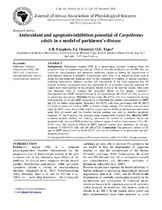| dc.contributor.author | Enogieru, A.B. | |
| dc.contributor.author | Omoruyi, S.I. | |
| dc.contributor.author | Ekpo, Okobi | |
| dc.date.accessioned | 2019-10-07T10:00:07Z | |
| dc.date.available | 2019-10-07T10:00:07Z | |
| dc.date.issued | 2018 | |
| dc.identifier.citation | Enogieru, A.B, Omoruyi, S.I. & Ekpo, O. (2018). Antioxidant and apoptosis-inhibition potential of Carpobrotus edulis in a model of parkinson’s disease. Journal of African Association of Physiological Sciences, 6(1), 126-135. | en_US |
| dc.identifier.issn | 2449-108X | |
| dc.identifier.uri | https://www.ajol.info/index.php/jaaps/article/view/182001 | |
| dc.identifier.uri | http://hdl.handle.net/10566/4987 | |
| dc.description.abstract | Background: Parkinson’s disease (PD) is a neurological disorder resulting from the progressive loss of dopaminergic neurons. There is currently no known cure for PD, thus the search for complementary and alternative medicines capable of halting the degeneration of dopaminergic neurons is plausible. Carpobrotus edulis (CE) is an indigenous plant used in South African traditional medicine used for the treatment of a number of disease conditions including tuberculosis, diabetes mellitus and constipation. It has been suggested that CE contains bioactive compounds which are responsible for its acclaimed medicinal potential. No studies have been reported on the potential benefit of CE to the nervous system. This study was therefore done to evaluate the protective effects of CE against 1-methyl-4-phenylpyridinium (MPP+)-induced toxicity in the dopaminergic SH-SY5Y cell line, as well as its underlying mechanism. Methods: In this study, SH-SY5Y cells were treated with varying concentrations of CE and MPP+ respectively to determine the optimal concentrations of MPP+ and CE for further experiments. Thereafter, SH-SY5Y cells were pre-treated with 30 μM of CE before exposure to 2 mM of MPP+ to induce cellular damage. Cell viability was evaluated using the MTT assay, intracellular reactive oxygen species (ROS) production was determined using flow cytometry and the Hoechst nuclear staining was used to visualize apoptosis. Caspases 3/7 and 9 activity was assessed using commercially available kits. Results: MPP+ treatment induced marked cell viability, increased the number of condensed nuclei and apoptotic cells, increased ROS production, initiated caspase 9 and activated caspase 3/7 in SH-SY5Y cells. The observed effects of MPP+-induced toxicity were attenuated by the pre-treatment of SH-SY5Y cells with 30 μM of CE. Conclusion: The protective effects of CE against MPP+-induced toxicity in SH-SY5Y cells may be attributed to its antioxidant and anti-apoptotic properties. | en_US |
| dc.language.iso | en | en_US |
| dc.publisher | African Association of Physiological Sciences | en_US |
| dc.subject | Parkinson’s disease | en_US |
| dc.subject | Carpobrotus edulis | en_US |
| dc.subject | SH-SY5Y cells | en_US |
| dc.subject | Reactive oxygen species | en_US |
| dc.subject | Apoptosis | en_US |
| dc.title | Antioxidant and apoptosis-inhibition potential of Carpobrotus edulis in a model of parkinson’s disease | en_US |
| dc.type | Article | en_US |

